The statistics about stress are staggering. According the American Psychological Association (APA) in 2017: Nearly eight in 10 people regularly experience physical symptoms caused by stress; almost half say they lie awake at night due to stress; and employers in the U.S. lose nearly $300 billion to stress-related health care and absenteeism.
As coaches, we get to meet clients at critical moments in their lives, where they are likely to be walking a fine line between stress and new levels of success and satisfaction and where they are open to learning new, practical ways of managing their stress.
For that reason, coaches who have a strong understanding of stress—what it is, how it works and how it can be managed—and who are willing to engage with clients in conversation about stress, are poised to increase the impact and efficacy of their coaching engagements.
The Stress Mindset Shift
The dominant cultural refrain about stress is familiar: We are all crazy busy. High stress is inevitable. It’s out of our control. The best we can do is learn a few tips and tricks, cross our fingers, and cope. In early conversation with clients, it’s helpful to listen for language that indicates this, or other unhelpful mindsets around stress, and then to work toward a more empowered mindset.
We might, for example, reframe stress as an early-warning system that indicates a need for increased awareness and increased self-care; both of which can be touched upon in coaching. This is a powerful shift away from the typical default response to stress, which is to double down, speed up and work even harder. This latter response is nice to utilize once or twice a year, but when it becomes the standard operating procedure, it’s a recipe for disaster.
Vulnerability
It can be helpful to remind clients that vulnerability to stressful experience does not spell weakness. It spells being a human being. It means our nervous system (in particular, that pesky limbic brain) is responding just as it should to changes in our environment. This is often a welcome perspective that clients can easily lose sight of in the crush of their day-to-day lives.
The Holmes-Rahe Life Stress Inventory, an assessment tool created by psychiatrists in 1967, lists 43 of the most stressful life experiences. Divorce and separation, getting married, losing a job and retiring are all among the top 10. With this in mind, we might ask our powerful questions of clients that get them thinking about the potential connections between, say, the current difficult period in their marriage and the impatience they have been experiencing with their direct reports.
We might encourage them to explore any given concern in light of what is happening in the rest of their life so that they might discover new ways of caring for themselves and building resiliency.
Awareness
While knowing what makes us vulnerable to stress is useful, it is not enough for people interested in building true resiliency. To become more resilient, it’s necessary to note the signs of stress early, before they become ingrained and problematic.
To do this, clients can take on a simple practice of noticing and charting out when their minds get caught in worrying about the future or troubling over the past. Once they become accustomed to noticing these reflexive habits of mind, it will become easier for them to pause, take a couple of deep breaths and refocus the mind on what’s most important in that moment.
We can design similar practices that train clients to pay attention to difficult emotions or tension in the body, both of which are important to address so that stress does not build up over time.
Deliberate Practice 
For many people, these in-the-moment mindfulness skills don’t come easily and the skill—yes, skill—of relaxing the body seems more challenging than a 16-hour work day. For these reasons, it is important to encourage clients to set aside time practice deliberately.
The initial time investment in deliberate practice can seem daunting for busy clients, but in the long run, most understand that it will make it easier for them to bring their skills into difficult moments and prevent long-term negative impacts of stress from taking hold.
Three tried-and-true practices that help reduce accumulated stress and prevent future stress from accumulating are progressive muscle relaxation, diaphragmatic breathing and mindfulness meditation.
Regardless of coaching niche or target market, all coaches will encounter clients who experience high levels of stress. In addition to applying our usual skills of powerful questioning and deep listening, sharing our knowledge of stress, working with our client’s mindset, increasing awareness and recommending (with permission!) simple practices can have a profound and positive impact on their lives.
Disclaimer
The views and opinions expressed in guest posts featured on this blog are those of the author and do not necessarily reflect the opinions and views of the International Coach Federation (ICF). The publication of a guest post on the ICF Blog does not equate to an ICF endorsement or guarantee of the products or services provided by the author.
Additionally, for the purpose of full disclosure and as a disclaimer of liability, this content was possibly generated using the assistance of an AI program. Its contents, either in whole or in part, have been reviewed and revised by a human. Nevertheless, the reader/user is responsible for verifying the information presented and should not rely upon this article or post as providing any specific professional advice or counsel. Its contents are provided “as is,” and ICF makes no representations or warranties as to its accuracy or completeness and to the fullest extent permitted by applicable law specifically disclaims any and all liability for any damages or injuries resulting from use of or reliance thereupon.
Authors
Post Type
Blog
Audience Type
Coach Educators, Experienced Coaches, External Coaches, ICF Chapter Leaders, Internal Coaches, New Coaches, Professional Coaches, Team and Group Coaches
Topic
Coaching Toolbox, Discover - Your Coaching Career
Related Posts
How Conscientious Inclusion Can Improve Your Coaching
Coaching continues to evolve as the world becomes more interconnected, multicultural, and…
The Coaching Trap: When Empathy Becomes Exhaustion
Prepare yourself for the fact that this will not be about you…
Your Guide to Preparing for the ACC Exam
Much like a smartphone upgrade that introduces improvements for a smoother user…








